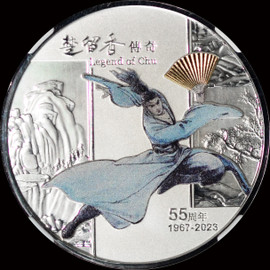This rare collectible is a piece of history that any Titanic enthusiast would be proud to own. Certified by NGC with a COA SERIAL #131, this coal was recovered from the boiler of RMS Titanic. It's a unique piece that reminds us of the tragic sinking of the Titanic and the lives lost on that fateful night. A perfect addition to any historical memorabilia collection or as a special gift for someone who appreciates the significance of this piece.
RMS Titanic was a British passenger and mail carrying ocean liner, operated by the White Star Line, that sank in the North Atlantic Ocean on 15 April 1912 as a result of striking an iceberg during her maiden voyage from Southampton, England, to New York City, United States. Of the estimated 2,224 passengers and crew aboard, about 1,500 died, making it the deadliest sinking of a single ship up to that time. The disaster drew public attention, spurred major changes in maritime safety regulations, and inspired many artistic works.
RMS Titanic was the largest ship afloat at the time she entered service and the second of three Olympic-class ocean liners built for the White Star Line. She was built by the Harland and Wolff shipbuilding company in Belfast. Thomas Andrews Jr., the chief naval architect of the shipyard, died in the disaster. Titanic was under the command of Captain Edward John Smith, who went down with the ship. The ocean liner carried some of the wealthiest people in the world, as well as hundreds of emigrants from the British Isles, Scandinavia, and elsewhere throughout Europe, who were seeking a new life in the United States and Canada.
The first-class accommodation was designed to be the pinnacle of comfort and luxury, with a gymnasium, swimming pool, smoking rooms, high-class restaurants and cafes, a Turkish bath, and hundreds of opulent cabins. A high-powered radiotelegraph transmitter was available for sending passenger "marconigrams" and for the ship's operational use. Titanic had advanced safety features, such as watertight compartments and remotely activated watertight doors, contributing to its reputation as "unsinkable".
Titanic was equipped with 16 lifeboat davits, each capable of lowering three lifeboats, for a total of 48 boats. However, she actually carried only 20 lifeboats. Fourteen were regular lifeboats, two were cutter lifeboats, and four were collapsible and proved hard to launch while she was sinking. Together, the 20 lifeboats could hold 1,178 people—about half the number of passengers on board, and one-third of the number of passengers the ship could have carried at full capacity (a number consistent with the maritime safety regulations of the era). The British Board of Trade's regulations required 14 lifeboats for a ship 10,000 tonnes. Titanic carried six more than required, allowing 338 extra people room in lifeboats. When the ship sank, the lifeboats that had been lowered were only filled up to an average of 60%.












